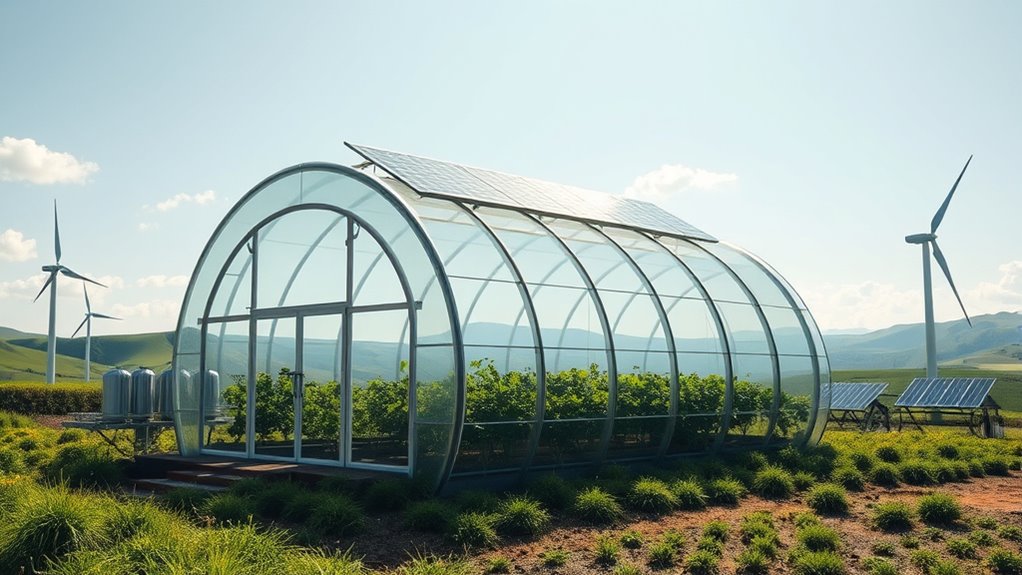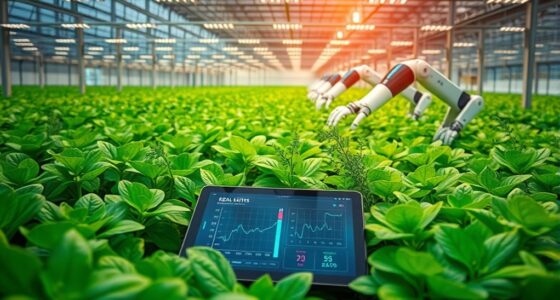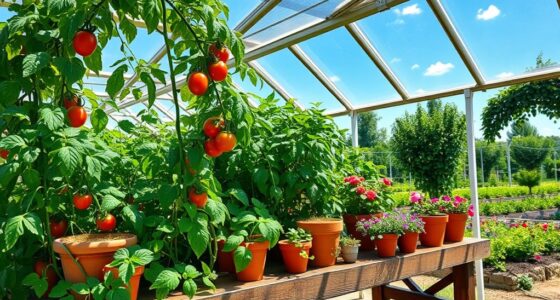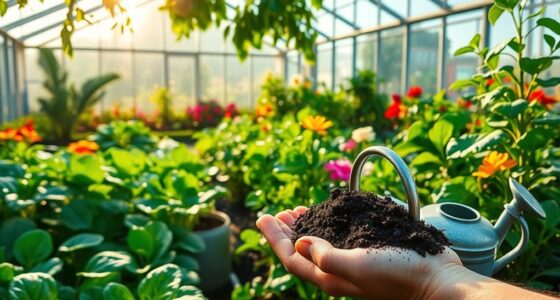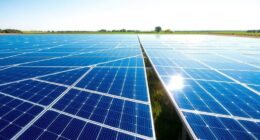Off-grid greenhouses help you grow fresh produce independently by using sustainable materials like recycled wood or bamboo and harnessing renewable energy such as solar power. With automation, solar sensors, and climate control, you can manage temperature, humidity, and watering efficiently. Remote monitoring allows you to stay connected and make adjustments easily. Their smart design maximizes energy use, making your farming more resilient and eco-friendly. Continue exploring to discover how to create a truly sustainable off-grid greenhouse setup.
Key Takeaways
- Utilize renewable energy sources like solar panels to power climate control and irrigation systems.
- Incorporate sustainable, locally sourced materials to build durable, eco-friendly greenhouse structures.
- Implement automated, solar-powered sensors for precise environmental monitoring and management.
- Design energy-efficient layouts with insulation and natural ventilation to maximize heat retention and airflow.
- Enable remote data access for real-time monitoring and adjustments, ensuring optimal conditions and reducing manual effort.
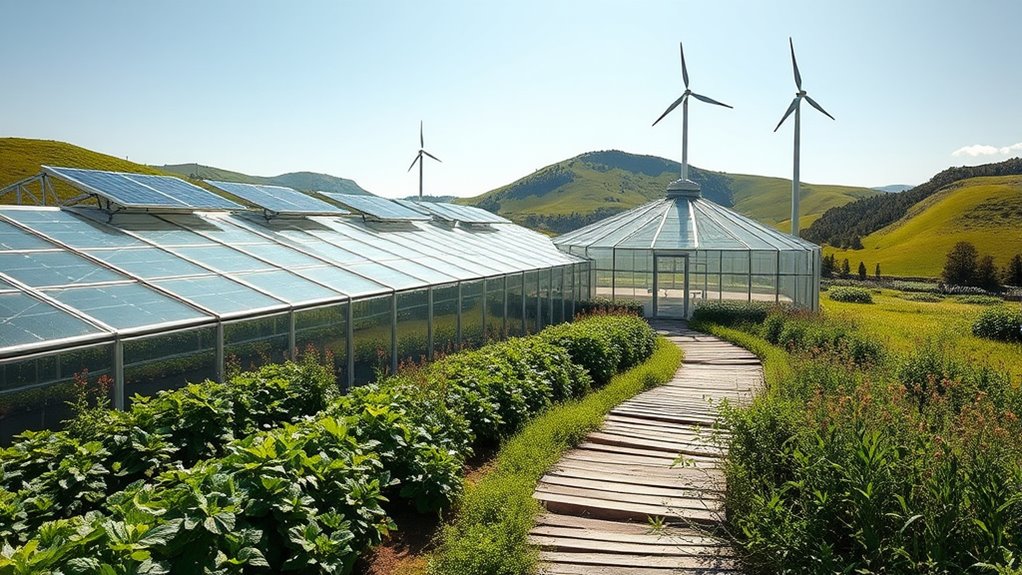
Have you ever wondered how to grow fresh produce sustainably without relying on the power grid? Off-grid greenhouses are the answer. They’re designed to give you energy independence, especially if you’re farming in remote areas. To make this happen, you’ll need to focus on sustainable materials that reduce environmental impact and incorporate automation technology to streamline your operations. Using sustainable materials like recycled wood, bamboo, or locally sourced bricks helps you build a greenhouse that’s both eco-friendly and durable. These materials not only lower your carbon footprint but also often cost less than conventional supplies. They’re better suited for off-grid setups because they don’t require the heavy manufacturing processes associated with traditional building materials.
Build eco-friendly off-grid greenhouses with sustainable materials like recycled wood and locally sourced bricks.
Automation technology plays a vital role in managing your off-grid greenhouse efficiently. With solar-powered sensors and programmable systems, you can control temperature, humidity, ventilation, and watering without needing a constant power supply. For example, solar-powered irrigation systems can water your plants precisely when needed, conserving water and energy. Automated climate control systems, driven by renewable energy sources, help maintain ideal growing conditions, even when you’re not physically present. This means less manual labor and a more consistent environment, which leads to healthier plants and better yields. Additionally, integrating renewable energy sources into your systems can further enhance their efficiency and sustainability. Proper planning of energy usage also helps mitigate potential regulatory compliance challenges associated with renewable systems.
Integrating automation technology also means you can monitor your greenhouse remotely through a smartphone or computer. You’ll get real-time data on temperature fluctuations, soil moisture levels, and sunlight exposure. If something’s off, you can adjust settings instantly or set up automated responses. This level of control makes managing your off-grid greenhouse less stressful and more predictable, ensuring your produce thrives year-round. Remote monitoring systems can significantly improve your ability to respond quickly to environmental changes.
Another key aspect is designing your greenhouse to maximize natural energy. Strategic placement and insulation with sustainable materials help trap heat during colder months and keep it cool in summer. Coupled with automation technology like solar fans and vents, you can optimize airflow and temperature regulation without external power. This combination reduces your reliance on external energy sources and keeps your operation fully self-sufficient. Additionally, energy-efficient design is essential for minimizing your overall energy use and ensuring your greenhouse remains sustainable in the long term. By carefully planning your layout and materials, you can further boost the greenhouse’s energy efficiency and resilience.
In short, creating an off-grid greenhouse that’s both sustainable and automated empowers you to grow fresh produce independently. By choosing sustainable materials for construction and leveraging automation technology for climate and water management, you build a resilient, eco-friendly system. This approach not only supports a sustainable lifestyle but also ensures you can produce healthy, fresh food in even the most remote locations.
Frequently Asked Questions
What Are the Initial Costs of Building an Off-Grid Greenhouse?
Your initial investment for building an off-grid greenhouse varies depending on size, materials, and technology used. Construction costs can range from a few thousand dollars for a small, simple setup to over $20,000 for larger, more advanced structures with solar panels and sustainable systems. Keep in mind, these initial costs cover materials, insulation, and basic systems, but investing wisely can reduce long-term energy expenses and boost your farm’s productivity.
How Do Off-Grid Greenhouses Handle Extreme Weather Conditions?
Braving brutal weather, your greenhouse’s resilience relies on robust insulation strategies and storm preparedness. You should seal gaps, add thermal layers, and reinforce structures to withstand fierce storms and freezing temperatures. Properly designed, these measures help maintain a stable environment inside, safeguarding your crops and equipment. By prioritizing insulation and preparedness, you guarantee your greenhouse stays strong, secure, and sustainable, no matter how extreme the weather gets outside.
What Are the Best Renewable Energy Sources for Off-Grid Greenhouses?
You should consider solar power and wind energy as the best renewable sources for off-grid greenhouses. Solar panels efficiently capture sunlight, providing reliable energy during the day, while wind turbines harness wind power, especially in breezy areas. Combining these sources guarantees a steady energy supply, reduces dependence on fossil fuels, and keeps your greenhouse sustainable and productive even in remote locations.
How Much Maintenance Do Off-Grid Greenhouses Typically Require?
Imagine you’re a pioneer on the frontier, and your greenhouse is your trusty steed. Maintenance frequency depends on your system’s durability; solar panels might need cleaning every few months, while wind turbines require regular inspections. Overall, off-grid greenhouses typically demand minimal upkeep—mostly routine checks and upkeep of renewable components. With proper care, your setup stays efficient, letting you focus on planting and harvesting instead of constant repairs.
Can Off-Grid Greenhouses Support Year-Round Crop Production?
You can definitely support year-round crop production with off-grid greenhouses, but it requires careful seasonal crop planning to optimize growth cycles. Incorporate water conservation strategies to manage limited resources effectively, especially in remote settings. Proper insulation, passive solar design, and renewable energy sources help maintain stable temperatures, enabling consistent crop yields throughout the year. These efforts guarantee your off-grid greenhouse remains productive regardless of external weather conditions.
Conclusion
Imagine your greenhouse as a sturdy lighthouse, standing tall amid a stormy sea, guiding your crops safely through unpredictable weather. Off-grid greenhouses light your path to energy independence, allowing you to grow sustainably no matter where you are. Just as a lighthouse provides steady guidance, these greenhouses empower you to take control of your farming future, offering resilience and freedom. Embrace this innovation, and let your remote farm shine bright with self-sustaining vigor.
